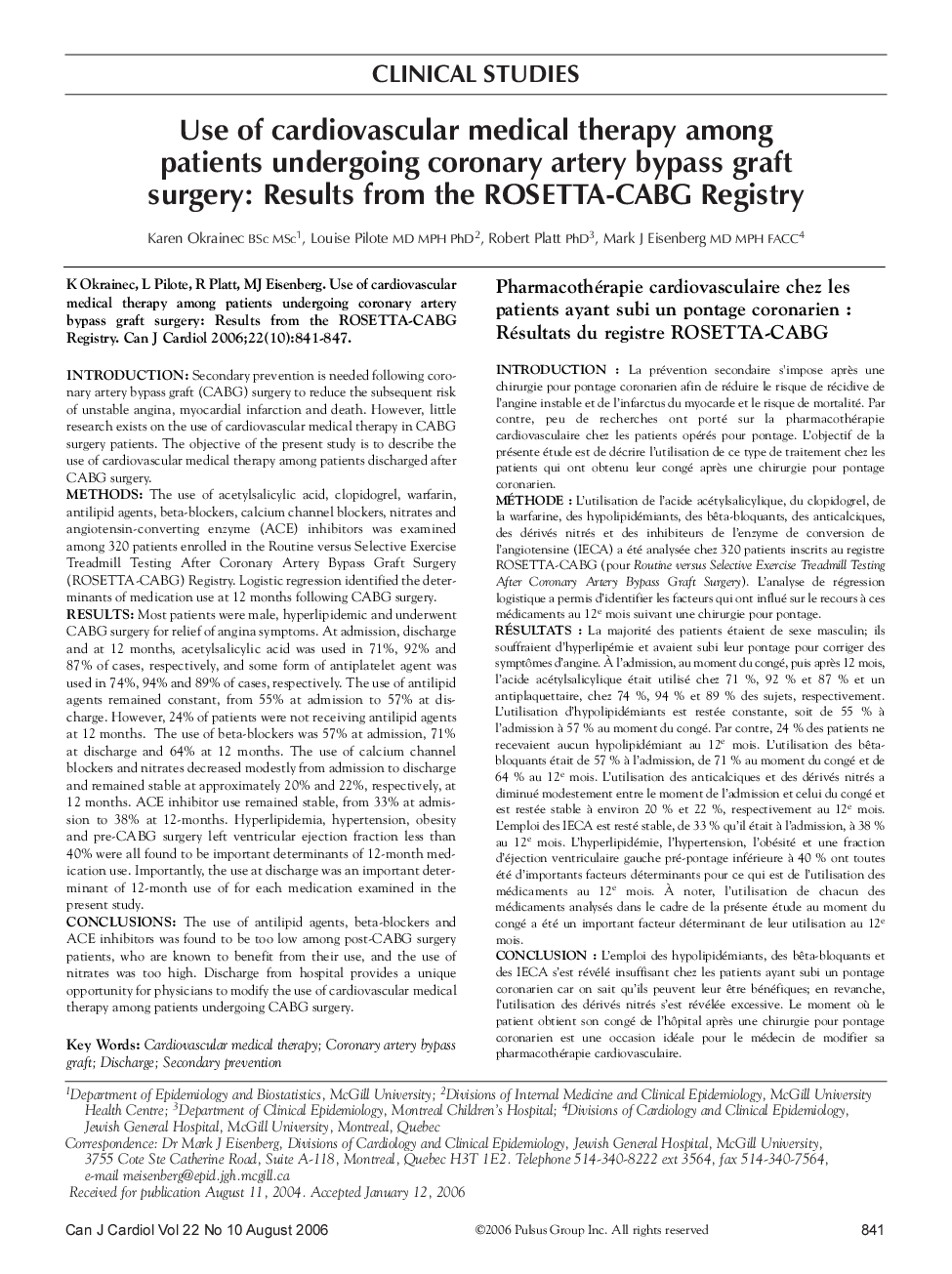| کد مقاله | کد نشریه | سال انتشار | مقاله انگلیسی | نسخه تمام متن |
|---|---|---|---|---|
| 2732871 | 1566613 | 2006 | 7 صفحه PDF | دانلود رایگان |

IntroductionSecondary prevention is needed following coronary artery bypass graft (CABG) surgery to reduce the subsequent risk of unstable angina, myocardial infarction and death. However, little research exists on the use of cardiovascular medical therapy in CABG surgery patients. The objective of the present study is to describe the use of cardiovascular medical therapy among patients discharged after CABG surgery.MethodsThe use of acetylsalicylic acid, clopidogrel, warfarin, antilipid agents, beta-blockers, calcium channel blockers, nitrates and angiotensin-converting enzyme (ACE) inhibitors was examined among 320 patients enrolled in the Routine versus Selective Exercise Treadmill Testing After Coronary Artery Bypass Graft Surgery (ROSETTA-CABG) Registry. Logistic regression identified the determinants of medication use at 12 months following CABG surgery.ResultsMost patients were male, hyperlipidemic and underwent CABG surgery for relief of angina symptoms. At admission, discharge and at 12 months, acetylsalicylic acid was used in 71%, 92% and 87% of cases, respectively, and some form of antiplatelet agent was used in 74%, 94% and 89% of cases, respectively. The use of antilipid agents remained constant, from 55% at admission to 57% at discharge. However, 24% of patients were not receiving antilipid agents at 12 months. The use of beta-blockers was 57% at admission, 71% at discharge and 64% at 12 months. The use of calcium channel blockers and nitrates decreased modestly from admission to discharge and remained stable at approximately 20% and 22%, respectively, at 12 months. ACE inhibitor use remained stable, from 33% at admission to 38% at 12-months. Hyperlipidemia, hypertension, obesity and pre-CABG surgery left ventricular ejection fraction less than 40% were all found to be important determinants of 12-month medication use. Importantly, the use at discharge was an important determinant of 12-month use of for each medication examined in the present study.ConclusionsThe use of antilipid agents, beta-blockers and ACE inhibitors was found to be too low among post-CABG surgery patients, who are known to benefit from their use, and the use of nitrates was too high. Discharge from hospital provides a unique opportunity for physicians to modify the use of cardiovascular medical therapy among patients undergoing CABG surgery.
IntroductionLa prévention secondaire s’impose après une chirurgie pour pontage coronarien afin de réduire le risque de récidive de l’angine instable et de l’infarctus du myocarde et le risque de mortalité. Par contre, peu de recherches ont porté sur la pharmacothérapie cardiovasculaire chez les patients opérés pour pontage. L’objectif de la présente étude est de décrire l’utilisation de ce type de traitement chez les patients qui ont obtenu leur congé après une chirurgie pour pontage coronarien.MéthodeL’utilisation de l’acide acétylsalicylique, du clopidogrel, de la warfarine, des hypolipidémiants, des bêta-bloquants, des anticalciques, des dérivés nitrés et des inhibiteurs de l’enzyme de conversion de l’angiotensine (IECA) a été analysée chez 320 patients inscrits au registre Rosetta-Cabg (pour Routine versus Selective Exercise Treadmill Testing After Coronary Artery Bypass Graft Surgery). L’analyse de régression logistique a permis d’identifier les facteurs qui ont influé sur le recours à ces médicaments au 12e mois suivant une chirurgie pour pontage.RésultatsLa majorité des patients étaient de sexe masculin; ils souffraient d’hyperlipémie et avaient subi leur pontage pour corriger des symptômes d’angine. À l’admission, au moment du congé, puis après 12 mois, l’acide acétylsalicylique était utilisé chez 71 %, 92 % et 87 % et un antiplaquettaire, chez 74 %, 94 % et 89 % des sujets, respectivement. L’utilisation d’hypolipidémiants est restée constante, soit de 55 % à l’admission à 57 % au moment du congé. Par contre, 24 % des patients ne recevaient aucun hypolipidémiant au 12e mois. L’utilisation des bêtabloquants était de 57 % à l’admission, de 71 % au moment du congé et de 64 % au 12e mois. L’utilisation des anticalciques et des dérivés nitrés a diminué modestement entre le moment de l’admission et celui du congé et est restée stable à environ 20 % et 22 %, respectivement au 12e mois. L’emploi des IECA est resté stable, de 33 % qu’il était à l’admission, à 38 % au 12e mois. L’hyperlipidémie, l’hypertension, l’obésité et une fraction d’éjection ventriculaire gauche pré-pontage inférieure à 40 % ont toutes été d’importants facteurs déterminants pour ce qui est de l’utilisation des médicaments au 12e mois. À noter, l’utilisation de chacun des médicaments analysés dans le cadre de la présente étude au moment du congé a été un important facteur déterminant de leur utilisation au 12e mois.ConclusionL’emploi des hypolipidémiants, des bêta-bloquants et des IECA s’est révélé insuffisant chez les patients ayant subi un pontage coronarien car on sait qu’ils peuvent leur être bénéfiques; en revanche, l’utilisation des dérivés nitrés s’est révélée excessive. Le moment où le patient obtient son congé de l’hôpital après une chirurgie pour pontage coronarien est une occasion idéale pour le médecin de modifier sa pharmacothérapie cardiovasculaire.
Journal: Canadian Journal of Cardiology - Volume 22, Issue 10, August 2006, Pages 841-847